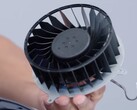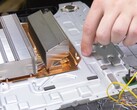Several Japanese media got to play with an actual PlayStation 5 (PS5) unit earlier this week, but they had restrictions in fully showing the console's internals and how effectively it is able to maintain relatively cool operating conditions. Now, Sony has published an official teardown of the PS5 detailing the innards of the cooling system, the custom AMD Ryzen Zen 2 + RDNA 2 SoC, and onboard SSD modules among others.
At 104 x 390 x 260 mm (W x H X D), the PS5 indeed looks larger than the PS4, which Yashuhiro Ootori, the VP of Mechanical Design at Sony and the presenter of the teardown video, says is justified given the dramatic improvement in processing powers and quietness compared to the previous generation.
There is a USB Type-A port and a USB Type-C 10 Gbps port on the front while the rear has two USB Type-A 10 Gbps ports, an Ethernet port, HDMI-out, and a power connection. The interior of the PS5 can be easily accessed by users by simply siding away either of the two side panels to reveal the 120 mm double-sided intake cooling fan. An M.2 PCIe interface for NVMe storage expansion is also seen.
Once inside, the UHD Blu-ray drive and the mainboard itself are seen. On the mainboard is the AMD Zen 2 8C/16T processor running at up to 3.5 GHz. The GPU component is an RDNA2-based engine running at up to 2.3 GHz and offering 10.3 TFLOPs. Flipping the board, we see eight GDDR6 modules that deliver a maximum bandwidth of 448 Gb/s. An onboard 825 GB SSD provides storage and along with the custom SSD controller, raw read speeds up to 5.5 GB/s can be achieved.
Given the massive heat output of the SoC, Ootori said they had use to use liquid metal as the thermal interface material (TIM) for improved heat transfer between the SoC and the heatsink. Liquid metal, though an excellent TIM, is not often used as it is electrically conductive and could short other system components if it leaks onto them.
Over on the PC side, enthusiasts take lots of precautions in carefully applying liquid metal to ensure that it does not leak. However, unlike on the PC side, Sony also has the challenge of shipping the PS5 worldwide, which can cause liquid metal to seep into other components during transit. Ootori said that the adoption of liquid metal has been in development for over two years. Sony would have addressed such concerns during development in all likelihood.
The other highlight of the cooling system is the massive heatsink. Ootori said that the shape and airflow of the heatsink have been designed in such a way to have an equivalent performance as a vapor chamber. The combination of liquid metal, the new heatsink design, and the 120 mm fan is the reason why early hands-ons noticed the console running relative cool while gaming. Finally, a 350 W PSU was also shown.
The complete teardown video can be seen below.





















